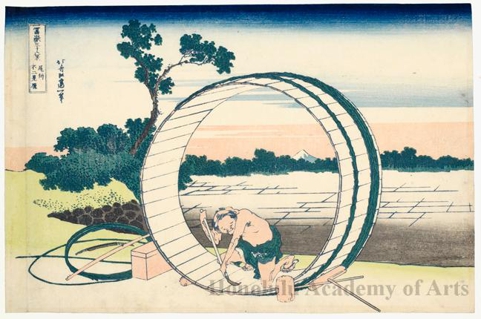
Title : Fujimigahara (“Fuji-view Fields") in Owari Province
Artist : Katsushika Hokusai
Date : c. 1830 - 1834
Details : More information...
Source :
Honolulu Museum of Art
Browse all 5471 prints...
Description : This print is best known for its bold, interesting composition that uses simple geometric forms. In the foreground, a huge tub is being made; inside it, a man works intently at sealing its seams. A tiny Fuji appears in the far distance, framed in the circle of the tub and across a plain of rice fields. Setting aside his usual interest in minute details, Hokusai here composes a design with only a few elements: bushes, a tree, the gigantic tub, the cooper with his tool box, saw, and hammers. The tub’s circle is repeated by the circular split-bamboo strips for hoops, lying on the ground. The small triangle of Mount Fuji provides a contrast in shape and size. Rows of rectangular rice fields connect the two. Though blue, greens, and gray are used, the yellow-green smoothly applied in the foreground dominates. The key-block was printed in blue. Geography was not one of Hokusai’s keen interests. It has been pointed out that Bishü, in present-day Owari province, some 150 miles west of Fuji, does not offer a view of the mountain. Hokusai paid no attention to this matter in his title for this wonderfully innovative print, which does not show any identifiable topographical features (Kondö 1966, no.10). (The Asian Art Museum of San Francisco, HOKUSAI AND HIROSHIGE – Great Japanese Prints from the James A. Michener Collection, Honolulu Academy of Arts: The Asian Art Museum of San Francisco, 1998 Page 64. Cat. 15) ***************** Despite Hokusai’s use of the name “Fuji-view Fields,” Owari Province (in the western part of modern Aichi Prefecture) is approximately 150 miles away from Mount Fuji, and there is no view of the volcano from this remote location. Hokusai’s inclusion of this province in the Thirty-six Views of Mount Fuji is therefore a mystery. As early as 1812, Hokusai published a painting manual advocating the use of basic geometric shapes as a foundation for artistic compositions. This print, with its bold circular barrel in the center, rectangular fields, and triangular Mount Fuji just visible in the distance, is an excellent example of the technique. While Hokusai was probably aware of Western compositional principles from sources such as Kömö Zatsuwa (Things in the West) published by the late Edo novelist Morishima Chüryö, he also foreshadowed many developments in nineteenth century European art, and Hokusai’s emphasis of geometric forms resembles ideas proposed by later artists such as the post-Impressionist Paul Cézanne (1839-1906). “Hokusai’s Summit: Thirty-six Views of Mount Fuji” (09/24/2009-01/06/2010) ******************************
Download ImageDo you have a similar woodblock print to sell?
Get in touch with us for a preliminary estimate and for information in selling your woodblock print.
GET IN TOUCH